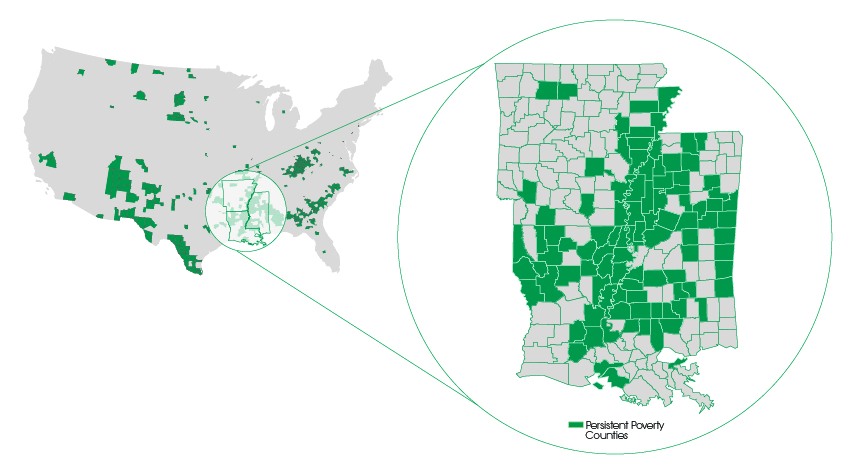Place Matters: Opportunities for Resiliency in Rural America
January 30th, 2017
Rural communities across the United States face a unique set of challenges in improving household financial security and mobility. This is particularly true in the Mid South where more than one-fourth of counties and parishes are in persistent poverty (a poverty rate greater than 20 percent for at least 30 years). See Map. Louisiana and Mississippi are the only two states where more than half the counties/parishes are classified as persistently impoverished. The vast majority of persistent poverty counties are rural.
Persistent Poverty Counties in the Mid South
Click to enlarge
In 2016, Pew Charitable Trusts hosted a briefing that revealed the complexity of the challenges faced by rural America as well as practices to increase opportunities and economic mobility in rural areas. Experts in the field of community development indicate that low access to “economic, financial, and social services and the migration of young professionals to urban centers” collectively hinder the potential for prosperity in rural communities. These obstacles, compounded by a lack of access to job markets, affordable housing, and transportation, only add to the challenges of economic mobility and underscore the need for policies and strategies that increase investments in high-poverty areas.
Strategies to Increase Rural Economic Mobility
Experts identified three strategies during the briefing that could increase economic mobility in high-poverty areas:
- Flexible community institutions. Community Development Financial Institutions (CDFIs), like HOPE, have a long-standing track record in investing in historically underserved people and places and providing financial services in low-income areas. CDFIs and other community institutions can serve a broad range of needs in rural markets. This includes offering financing and development services, as well as providing affordable credit and retail financial services where bank branches are oftentimes scarce.
- Creative collaboration. Collaborative efforts among social service agencies, particularly those implementing anti-poverty programs, create a unique opportunity to provide rural communities with expertise, like cross-training staff to serve a variety of clients.
- Technology as a bridge to opportunity. Technological limitations can plague rural communities, oftentimes affecting education and workforce opportunities. Institutions of higher learning can help bridge the technological gap by acting as small business incubators and high-speed Internet access points as well as using broadband to make technology more inclusive in rural communities.
The practices of flexibility, collaboration and technology reaffirm the need to invest in underserved areas and develop opportunities that foster job creation, affordable housing, and access to financial services that help create better life outcomes for people in rural communities.
Sources:
Community Development Financial Institutions Fund. Persistent Poverty Counties. Retrieved from http://www.mycdfi.cdfifund.gov/what_we_do/persistentpoverty.asp
Opportunity Finance Network. What is a CDFI? Retrieved from http://ofn.org/what-cdfi
Sattelmeyer, S. (2016). 3 strategies to increase opportunity and economic mobility in rural America. Retrieved from http://www.pewtrusts.org/en/research-and-analysis/analysis/2016/07/18/3-strategies-to-increase-opportunity-and-economic-mobility-in-rural-america








